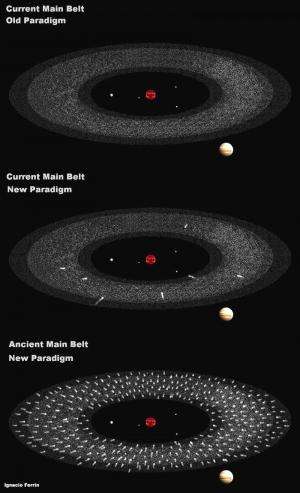Research team explains 'Lazarus' comets

Astronomers from the University of Antioquia have discovered a graveyard of comets. These once-dormant comets, dubbed by astronomers as "The Lazarus comets," are now rejuvenated.
The study of comets is an important area of Astrophysics because these objects collide with the Earth from time to time, and there is even the theory of panspermia, that claims that comets may have transported life to Earth. It is thus important to study these objects to know their properties and lifetimes and their influence on our planet.
The current Main Belt of Asteroids, between the orbits of Mars and Jupiter, contains more than 500.000 objects, from 1 m in diameter to 800 km. The traditional paradigm is that these objects are the remains of a planet that never came to be. Thus, we would not expect to find comets among the debris.
However, in the last decade 11 comets were discovered in this region. And, questions remain: Why are these comets active? And, how old are they?
Astronomers Ignacio Ferrín, Jorge Zuluaga and Pablo Cuartas from the University of Antioquia in Medellin, Colombia, think they know the answers.
"We found a graveyard of comets", said Professo Ferrín. And he adds: "Imagine all these 500,000 asteroids going around the Sun in those sidereal spaces, absolutely dark, absolutely cold, and absolutely silent, year after year, eons after eons. Except that we have found that some of those objects are not dead, but are dormant comets that may come to life if the energy that they receive from the Sun increases by a few percent. That is what we are seeing today in the main belt of asteroids".
According to this interpretation, millions of years ago, the main belt was populated by thousands of active comets. This population aged and the activity subsided. What we see today is the residual activity of that glorious past. Eleven of those rocks are true comets that were rejuvenated due to a diminution of their perihelion distance. This is what the astronomers from the Univesity of Antioquia discovered. The little extra energy they received from the Sun was sufficient to revive them from the graveyard.
"Although comets probably did not bring all the water to the Earth as we thought in the past, they could have played a very important role in determining the evolution of the ancient Earth atmosphere", points out paper coauthor Pablo Cuartas. "Everything we can learn about comets, their original distribution in the early solar system and present distribution and evolution, could help us at unveiling important details about the evolution of this and other planetary systems", said Prof. Jorge Zuluaga.
A paper detailing the team's results has been accepted for publication in the Monthly Notices of the Royal Astronomical Society. A preprint of their paper can be found at the FACom website or in the arXiv repository under the number arXiv:1305.2621.
Journal information: Monthly Notices of the Royal Astronomical Society
Provided by University of Antioquia


















